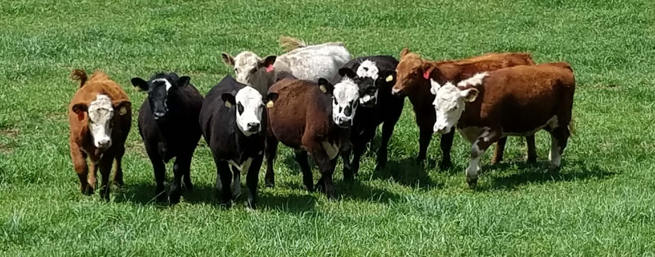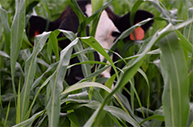Summer Grazing Tips
 Cool-season Grass Pastures (i.e. fescue, orchardgrass, ryegrass)
Cool-season Grass Pastures (i.e. fescue, orchardgrass, ryegrass)
- Depending on the species, 60 to 70% of the growth of cool-season grasses occurs early in the grazing season when temperatures are below 75°F with another increase in productivity seen in the fall. In the spring when the growth of grasses is rapid, cattle should be rotated rapidly between paddocks in an attempt to keep forages vegetative. Spring rotations between paddocks or fields may be 14 days or less. When environmental temperatures increase and soil moisture becomes limiting, growth of these grasses slows. Thus, rest time for plants between grazing periods needs to be increased. Depending on rainfall and environmental temperatures, rest periods in the summer can be 30 to 45 days or longer.
- On average, grass pastures should be grazed no shorter than 3 to 4 inches. At this height, more tillers remain at the base of the plant as well as some residual leaf area, allowing the plant to grow back quickly. This practice is especially important during drought situations to allow rapid regrowth after rainfall.
- During the summer, additional acreage and/or forage species which grow in warmer temperatures are needed to supply adequate forage. If forage quality or quantity is inadequate, stored forage should be fed. Don’t sacrifice your pasture plants for a few more days of grazing. Not only is overgrazing hard on pastures, but we all recognize that content and full-bellied cattle are more likely to stay inside fences!
Preparing Fields for Stockpiling Fescue
- In early August, graze fescue pastures to remove forage growth, leaving 3 to 4 inches of residual. Remove cattle from fields to be stockpiled allowing forage to rest and recover.
- Mow weeds and mature forage if needed to promote vegetative regrowth. These fields will not be regrazed until November to January depending on fall forage availability.
- If economical, apply nitrogen fertilizer (40 to 80 lbs of actual nitrogen per acre) in mid-August. Generally, the addition of nitrogen in August increases forage yield when adequate soil moisture is available. UK Ag Economists annually calculate whether the addition of nitrogen will be economical for stockpiling based on nitrogen and hay prices and reading this information will aid in decision making.
- In November/December, begin strip grazing the stockpiled fescue. Strip grazing improves utilization. Backfencing is not required. At least every 3 days, move the temporary fence to provide an additional amount of stockpiled fescue.
- Manage under the principal of “Use it or Lose it.” Quality of the stockpiled fescue is generally higher than hay. The quality of the stockpiled fescue does over the winter with the highest quality in the green material and declining quality declining as it turns brown.
- In February, this pasture would be an excellent candidate for frost-seeding with clover since forage residue has been removed.
Grazing Green Corn
- “Green Corn” refers to corn grazed in the vegetative or leafy stage of maturity. The corn plant may or may not have ears.
- To reduce field waste, corn should be strip grazed where temporary fencing provides an area to be grazed. Pushing down a few rows of standing corn by driving over it with an ATV allows the construction of a temporary fence, makes the fence visible to cattle, and prevents corn from blowing down on the fence. No back fencing is required since the plant will not regrow.
- Ideally, cattle should be given no more than the amount they can consume within 2 to 3 days. This management practice allows for more uniform cattle grazing patterns and improved forage utilization. When and if mature ears are present, a short grazing period also forces the cattle to consume adequate fodder (leaves and stalk) to prevent acidosis from high amounts of grain consumption.
- During rainy conditions, cattle should be removed and placed on other grass-based pastures or grassy lots to prevent extremely muddy conditions in the corn fields.
- During drought conditions, nitrates can accumulate in the corn plants. Samples of corn plants should be taken and tested before cattle graze these fields to avoid nitrate toxicity.
 Grazing Alfalfa or Alfalfa-grass Pastures
Grazing Alfalfa or Alfalfa-grass Pastures
- Alfalfa grows best when temperatures are between 65 and 90°F, at slightly higher temperatures than cool-season grasses. This characteristic extends grazing later into the summer. Also, alfalfa plants have a deep tap root that allows them access to moisture deeper in the soil than grasses. Thus, alfalfa has a higher probability of growing and providing grazing during times of mild drought stress.
- Paddocks should be sized such that the animals eat the entire plant (stem and leaves) versus just the top of the plant. The top of the plant consists primarily of leaves, which are high in protein with little fiber. The stem is lower in protein and higher in fiber. By restricting the area grazed, cattle will consume the entire plant more uniformly, which also helps minimize bloat risk.
- Under wet, muddy weather conditions, cattle should be removed from alfalfa fields to protect the crown of the plant from hoof damage. Cattle should be moved to another pasture with a good sod base.
- Manage to reduce the risk for bloat. These management practices include, but are not limited to: (1) moving cattle to pastures after the morning dew has dried and cattle have grazed in the morning, (2) do not put hungry cattle on alfalfa pastures, (3) avoid grazing immature alfalfa, (4) do not remove cattle at the first sign of bloat, (5) observe cattle closely, (6) provide a small amount of dry grass hay, and (7) feed bloat-reducing compounds, such as poloxalene.
- In the fall, alfalfa should not be grazed or harvested between September 15th and a killing frost (or November 1st) to allow the plant to store root carbohydrates and improve winter survival.
Warm-Season Annuals (Examples: Sudangrass, Sudex, Pearl Millet, and Crabgrass)
- Warm-season annuals provide excellent grazing during the summer when cool-season grasses are less productive and are useful when renovating pastures to provide grazable forage prior to fall seeding. They can be used in a rotation with winter annuals in the same field to extend the grazing season.
- Sudangrass, sorghum-sudangrass (sudex), and pearl millet plants should not be grazed until they are at least 18 to 24 inches in height (knee high) and cattle removed when they are grazed to 8 to 12 inches. Crabgrass should be grazed to no shorter than 3 inches in height with grazing starting at less than 10 to 12 inches. After a killing frost, palatability of crabgrass is very low.
- To optimize the use of forage, cattle should graze an area for no more than 7 days to allow for regrowth. With the exception of German (foxtail) millet and soybeans, most warm-season annuals will regrow, thus providing several grazings during the summer.
- Brown midrib (BMR) varieties contain a lower amount of lignin which increases digestion and the amount of energy cattle receive from the forage. BMR varieties should be used when grazing cattle with high nutritional needs (i.e. stockers, lactating beef cows, dairy cows, or creep grazed beef calves).
- Cattle should be removed from sudangrass, sorghum-sudangrass, and fields containing johnsongrass when frost is expected to prevent prussic acid or cyanide poisoning. For a non-killing frost (temperature greater than 28°F) wait two weeks before grazing again. Following a killing frost (below 28°F), wait until the material is dry and brown (usually the toxin dissipates within 72 hours). Pearl millets do not have the risk for prussic acid or cyanide poisoning.
- During droughts or under heavy nitrogen fertilization, nitrate toxicity can be a problem. Under these conditions and before allowing cattle to graze these forages, samples should be collected and tested to determine if this problem potentially exists.
Warm-Season Perennial Grasses (Examples: Bermudagrass, Eastern Gammagrass)
- Warm-season perennial grasses grow best when temperatures are 80 to 95°F when growth of cool-season grasses has slowed.
- Bermudagrass is a sod-forming perennial grass which is very productive in Kentucky during June, July, and August. Grazing should begin when the average plant height is 6 to 8 inches and stop grazing at not less than 2 inches in height.
- With Eastern gammagrass and other native warm-season grasses, rotational grazing practices must be followed where cattle are removed when the average plant height reaches 8 to 10 inches. Grazing these clump-forming grasses usually begins when plants are vegetative and average 18 to 22 inches in height. Each paddock should be grazed less than 5 to 7 days and allowed 28 to 45 days between rotations depending on weather conditions. Continuous grazing will result in the loss of the stand.
- Cattle should be removed from native warm-season grasses by the end of August to allow the roots to store carbohydrates to survive the winter. Eastern gammagrass, unlike other native warm-season perennials, can be regrazed after a killing frost.
- Graze then rest: Alfalfa and alfalfa-grass stands need to be rotationally grazed where the forage is grazed beginning at a height of 15 to 20 or higher inches and cattle are removed when forage is grazed to no shorter than 3 inches. Plants are allowed to regrow without grazing for 25 to 40 days. This rest period is needed to extend the life of the stand and for optimum plant growth.
- Cattle should not graze alfalfa plants longer than 3 to 5 days since new shoots start to develop after this time frame. Ideally, cattle should be rotated at least every 3 days to new paddocks. Cross fencing within a paddock can be used to achieve a shorter grazing period.
Categories:
Summer
Grazing Systems


